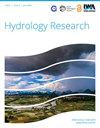用尺度选择方法预报洪水范围的多系统比较
IF 2.4
4区 环境科学与生态学
Q2 WATER RESOURCES
引用次数: 0
摘要
河流洪水预报系统越来越多地将河流流量与洪水图库或实时水动力模型相结合,为人道主义机构提供洪水预报图。洪水预测图可以与潜在影响联系起来,为基于预测的融资计划提供信息。通过对三个洪水预报系统的评价,探讨了尺度选择验证的新应用。两个模拟库系统,洪水预测(30米)和GloFAS快速洪水测绘(1000米),以及一个水动力学建模系统,孟加拉国洪水预报和预警中心(FFWC)超级模型(300米),都对2020年7月孟加拉国贾穆纳河洪水在不同空间尺度(括号内的网格长度)的洪水程度进行了预测。洪水图是根据合成孔径雷达衍生的洪水观测结果进行验证的,使用了一种可以直接在不同空间尺度上进行比较的尺度选择方法。在较短的预测周期内,超级模型优于其他系统。在孟加拉国边境附近,这两个全球系统的跨界效益是显而易见的。我们发现尺度选择方法可以量化系统在不同空间尺度上运行的技能,从而可以评估其优势和局限性。洪水地图的多系统比较对于改进基于影响的预报和确保资金和应对活动的适当针对性非常重要。本文章由计算机程序翻译,如有差异,请以英文原文为准。
A multi-system comparison of forecast flooding extent using a scale-selective approach
Abstract Fluvial flood forecasting systems increasingly couple river discharge to a flood map library or a real-time hydrodynamic model to provide forecast flood maps to humanitarian agencies. The forecast flood maps can be linked to potential impacts to inform forecast-based financing schemes. We investigate a new application of scale-selective verification by evaluating three flood forecasting systems. Two simulation library systems, Flood Foresight (30 m) and GloFAS Rapid Flood Mapping (1,000 m) and one hydrodynamically modelled system, the Bangladesh Flood Forecasting and Warning Centre (FFWC) Super Model (300 m), all made predictions of flooding extent at different spatial scales (grid lengths, in brackets) for the Jamuna River flood, Bangladesh, July 2020. The flood maps are validated against synthetic-aperture-radar-derived observations of flooding using a scale-selective approach that can compare directly across different spatial scales. At short forecast lead times, the Super Model outperforms the other systems. Near to the Bangladesh border, the trans-boundary benefits of the two global systems are evident. We find that scale-selective methods can quantify the skill of systems operating at different spatial scales so that the benefits and limitations can be evaluated. Multi-system comparison of flood maps is important for improving impact-based forecasts and ensuring funds and response activities are appropriately targeted.
求助全文
通过发布文献求助,成功后即可免费获取论文全文。
去求助
来源期刊

Hydrology Research
WATER RESOURCES-
CiteScore
5.00
自引率
7.40%
发文量
0
审稿时长
3.8 months
期刊介绍:
Hydrology Research provides international coverage on all aspects of hydrology in its widest sense, and welcomes the submission of papers from across the subject. While emphasis is placed on studies of the hydrological cycle, the Journal also covers the physics and chemistry of water. Hydrology Research is intended to be a link between basic hydrological research and the practical application of scientific results within the broad field of water management.
 求助内容:
求助内容: 应助结果提醒方式:
应助结果提醒方式:


